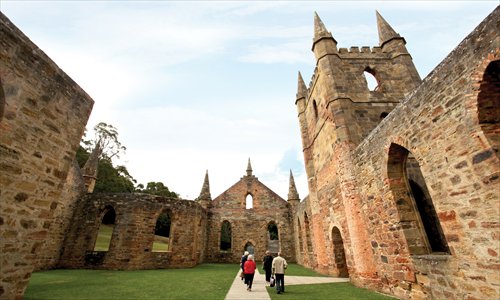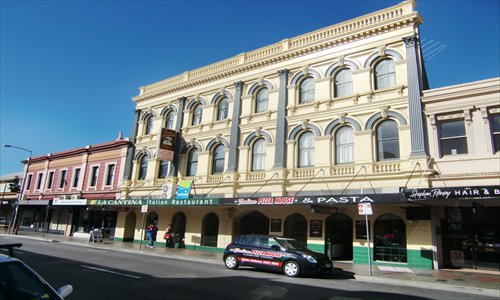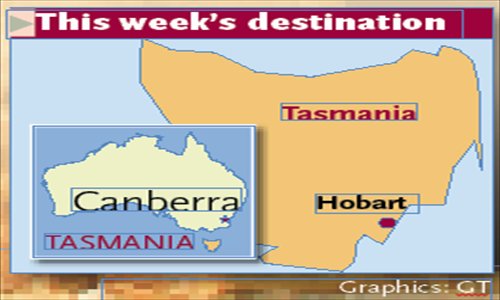Taken by Tasmania



Around 200 years ago, Australia's southernmost island colony of Tasmania, then known as Van Diemen's Land, was regarded as the "gateway to hell" by convicts tasked with building a country still in its colonial infancy. Its surrounds of icy waters and rugged mountains made it the ideal place to banish the worst criminals, who likely viewed escape impossible - not that there weren't a handful bold enough to try.
Today, "Tassie" offers far more to visitors than historic shackles to its convict heritage. Pristine wilderness, abundant wildlife, gourmet food, beer and wine and an emerging art scene are just some of the allures that tempt tourists across the Bass Strait.
Long overshadowed by mainland Australian states, whose inhabitants are mostly familiar with Tasmania (and Tasmanians) as the butt of countless jokes, the "apple isle" invites travelers to venture the furthest "down under" in the land Down Under.
We are on a five-day drive beginning from the cozy capital Hobart and winding a trail of uninterrupted coastline and expansive plains that have changed little since it was sighted in 1642 by Dutch explorer Abel Tasman, whom the island is named after.
Hobart: diamond on the Derwent
For most visitors to Tasmania, the first port of call will be Hobart, Australia's second oldest city after Sydney. Straddling the scenic Derwent River where maxis jostle for line honors in the annual Sydney to Hobart Yacht Race, the city is immediately distinguishable from other Australian state capitals for its skyline dominated by mountains rather than skyscrapers.
Don't despair if you don't drive or aren't game enough to test your motoring skills on the left side of the road; downtown is 15 kilometers from the airport and taxis or paid shuttle buses run to the town center.
It's worth timing your visit to Hobart to fall on a weekend to include a leisurely date with the Salamanca Markets. Held each Saturday on the waterfront, there are countless stalls offering everything from fresh produce to handicrafts.
Convict heritage in Port Arthur
If Tasmania was the "gateway to hell" for convicts centuries ago, Port Arthur was arguably hell itself. Located an hour-and-a-half drive through winding, bush-lined roads from Hobart, the Port Arthur Historical Site is probably the most vivid, albeit chilling, reminder of Australia's convict era.
From a distance, it's easy to assume you've stumbled on a sprawling Victorian era estate that's fallen on tough times. In reality, it's a 40-hectare open air museum. Among the ruins is a penitentiary, gothic-style church, hospital and one-time mental asylum majestically perched on the top of a hill overlooking the ocean; the idea being fresh air and still waters of the Tasman Peninsula would bring peace to tormented minds.
Port Arthur served as a penal colony from 1833-53, holding some of the most despised British and Irish convicts who must have felt condemned to a fate marginally better than death. Out of respect for the inhumane treatment that convicts, some as young as 9, suffered at Port Arthur, there are no reenactments. Instead, it's worth spending an extra few dollars to hire an audio guide featuring diary transcripts of the penal colony's past commandants and inmates.
Plan to spend at least half a day in Port Arthur. Entry is A$85 ($89.40) and A$55 for children (family passes available). There's even a digital registry detailing all of Port Arthur's convicts, allowing Aussies of lawbreaking lineage to trace their criminal ancestry.
For the record, I'm assured John Fearon transported from Scotland to Port Arthur aboard the Elphinstone in 1836 was sentenced to his seven-year stretch for petty theft on questionable evidence.
Between Port Arthur and Hobart is the Tasmanian Devil Conservation Park, a worthwhile visit for anybody curious about Australia's most ill-tempered marsupial or just eager to feed some of its more hospitable ones.
Tasmanian devils are the not-so-cuddly icons of the state. Over the past decade, their numbers have been decimated by a facial tumor disease. Concerned, the state government intervened and set aside an insurance population of disease-free animals at wildlife parks, such as the Tasmanian Devil Conservation Park. Admission to the park might seem pricey at A$35, but revenue helps fund conservation efforts.
Big charm in small Midlands towns
The next day we hit the open road bound for Launceston. The journey is the best part of three hours from Hobart, but we allow for a leisurely five to include stops at some of the historic towns along the way.
We have a morning tea of scones and coffee at Oatlands, a town of just over 500 located 84 kilometers north of Hobart. The slow-paced lifestyle can be immediately felt moments after getting off the Midland Highway.
Historic sandstone buildings including a post office that opened in 1832 and Georgian-style courthouse are among the impressive feats of convict construction still standing.
After another hour cruising up the highway, we are seduced for a late lunch by another exit, this time lined by orchards, that leads to the town of Ross. Once an important garrison between Hobart and Launceston and a hub for trade, today it leads a quiet existence that only pipes up when the odd vacationing family or couple pulls in for a pit stop.
As a resident of Beijing where construction never stops and cranes tower over the cityscape, there is simple pleasure to be found in strolling over the pride of the town: the 177-year-old Ross Bridge. Running a hand over its stubble-like sandstone locals still depend on to cross the Macquarie River into their sleepy town offers newfound appreciation for the art of stonemasonry.
Losing yourself in Launceston
By mid-afternoon we arrive in Launceston, or "Lonnie" as locals readily correct us. Nestled in the basin of the Tamar River about 200 kilometers northwest of Hobart, Tasmania's second biggest city boasts quiet streets lined by Victorian and Georgian architecture.
There seems to be a surplus of churches in a city of 106,000, but the sight of the sun sinking beyond centuries-old steeples offers an impressive sight - even if you have to wait until nigh on 9 pm to see it.
Launceston's premier tour attraction, the tranquil Cataract Gorge, lies a 15-minute walk southwest of the town. The ravine boasts what is believed to be the longest single span chairlift in the world at 308 meters, which offers a bird's eye view of the gorge's three main basins. A return trip on the chairlift will cost you A$15.
The first basin is a favored haunt for locals during summer, with swimmers having their choice of a pool or the 19-meter-deep gorge to cool off.
Hikers will enjoy tackling the criss-crossing trails that allow up close and personal encounters with wildlife, including peacocks and black-nosed Bennett's Wallabies, a diminutive relative of the kangaroo.
Walking back into town from the gorge allows us to amply dry off our swim, but the heat has left us parched. Resisting the temptation to sink into a leather booth at a boutique pub, we take up a stool at Dickens Ciderhouse, the city's first cider bar that opened mid-2012.
Mesmerized by MONA
Back in Hobart, we save our last full day in Tasmania for the Museum of Old and New Art (MONA), a waterfront art museum located within the Moorilla winery. The museum is the A$100 million private collection of local professional gambler David Walsh.
Thought-provoking, mesmerizing and at times just plain weird and spooky, artworks are thoughtfully exhibited on three underground floors in the A$80 million gallery that feels more like a super villain's lair.
Rules of Thumb
When to go: Tasmania experiences four distinct seasons, each offering different adventures to travelers. Generally speaking, October-April is the best period.
Where to stay: There is accommodation to suit every budget in Tasmania, ranging from five-star waterfront hotels and rustic bed and breakfast inns to simple, low-cost motels and pub dorms. It's best to book ahead before visiting to avoid disappointment.
Transportation: It's best to rent a car for the entirety of your trip, but booking ahead with a reputable company is essential unless you're willing to drive a lemon rented from a downtown used car dealership or, worse still, depend on infrequently running public buses.
Drive safe: Tasmania's expansiveness means you'll be in for a lot of highway driving if you plan to visit different cities. Few roads are sealed and the hazard of hitting wild animals, particularly on roads snaking through bushland, is evident from the common sight of roadkill.
Getting there and away: Direct flights operate daily from all eastern capital cities to Hobart. The Spirit of Tasmania is a ferry service that operates between Melbourne and Devonport in northwest Tasmania.